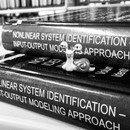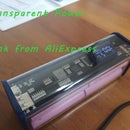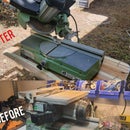Introduction: Perfect Compact Circular Saw From a Dinosaur
I've never had a dedicated shop space.
Also, my projects are rarely on a very large scale.
That's why I love small and compact things: they don't take much space and can be stowed away when not in use. The same goes for my tools.
I've wanted a circular saw for a while. But all the standard offerings are large and frankly they are overkill for my purposes.
Small (cordless) saws are perfect for hobby grade use and occasional projects, and they are really cute.
They were popular like 10-20 years ago, but today not as much (certainly not on a budget).
The latter gives us an opportunity to make a modern version with a tiny investment.
Making it Lithium powered and charged via USB makes it the perfect choice for a small scale DIYer like myself.
Do you want one? Follow along!
And if you liked this instructable, consider voting for it in the Build a Tool Contest. Thank you!
Step 1: Getting Your Saw
This particular tool comes in two flavors:
1. Craftsman model 900.112650
2. Black&Decker VP600
It's the same saw just different colors, you can get either.
It uses a 3 3/8" blade and supposed to be powered with 7.2V (2x3.6V VersaPaks) - an ancient NiCd batteries.
You can find tons of listings on ebay, here are several examples:
Mine was 6$ w/o shipping, so it's very cost effective.
Mine came in descent shape, but there may be variations.
Also, you might have one laying around and collecting dust, in this case it's free.
**Note: There are other tools which use 2 VersaPak sticks, this instructable will also apply there.
Step 2: What You'll Need
1. The saw :)
2. Two 18650 Lithium Ion cells. Something like this, or this.
3. 2s USB charger, like this one. I used it in this build, and it works surprisingly well.
4. 2s bms (optional). I used this one, but it's not recommended (more on this later)
5. Female charging jack, here or here.
Some loose wiring.
Access to 3d printer.
T10 screwdriver (for disassembly)
Hot glue gun.
Soldering iron.
Hand tools.
Step 3: Open It
First thing first: Take the blade off! (seriously do it) it will be much safer this way.
Keep the two washers and the blade retainer bolt somewhere safe. The bolt is left threaded and can't be replaced easily once lost.
1. Push out the two c-pins that hold the base plate to the body (one is longer). Wide enough screwdriver and light hammer taps will do the trick.
2. Unscrew 8 T10 bolts that hold two case pieces together.
There isn't much to do inside, just clean the dust/dirt from years of storage.
Make sure the on/off unit is functional.
Step 4: Print the Cap(s)
You can find the .stl files here - Thing: 3512505
cap1.stl is required
cap2.stl gives it a little more bling :) and it's optional.
The lithium batteries will be placed in the same compartment as the old ones.
But they are smaller in diameter, so an adapter is needed.
The locations for lithium cells are not centered, this is done on purpose.
Step 5: Make the Power Unit
It's time to make the juice unit that will drive the saw into the future.
- Take your female charging port, solder wires and secure it in place, see pic. Route the wires out.The nut is a bit challenging to operate, but it's manageable and you can add hot glue for final fix.
- Solder pieces of wire to the batteries. One cell to the positive side, one cell to the negative side.
- Push these in the 3d printed adapter with the wired ends in. There is a channel to route the wires in between the cells.Secure with hot glue.
- These two leads come together to the BM pad on the BMS unit.
- Secure the BMS unit to one of the cells with hot glue.
- Run the other ends of the batteries to the B+/- pads.
**Side note about this BMS unit: Ideally charging leads and those that go to the motor should be connected to +/-P pads on the unit. However, this one is probably faulty (for me or the basic model). So I ended up connecting everything to +/-B pads. Effectively this cancels the functionality of the BMS - so it's entirely optional.
***Please let me know if there is a 2s BMS unit that worked for you. Thanks!
Step 6: Make the Charger
Take the charger unit and snip off the black connectors.
I've found a piece of power cord with correct plug, you'll probably have something like this laying around.
If not, get something like this.
Solder the leads to appropriate pads.
Then put some hot glue on the interface between the cord and the charger.
Heat shrink it all, you're done.
For heat shrinks, various sizes, just get this. You'll thank me later.
It's a good idea to charge your newly assembled unit and check that everything works.
Step 7: Grease It (if You Are Already Here)
As long as the unit is open, we might just go ahead and give the gears a treat.
There are two stages to the gearbox. Each one is enclosed in separate compartment and held by it's own bolts.
Open them up and grease the gears with generous amount.
Step 8: Wire It Up
Take your power assembly and put it in the case where it should be.
Then take the output wires and solder them to the contact leafs inside the saw
Positive goes to white and negative to the black.
Put several blubs of hot glue to secure it in place
Close it and you are done with the hard stuff.
Now, you can add the "vanity plate" to the end. Just for fun.
After all, it's not an ordinary saw now.
Step 9: Put the Plate Back & Optional New Blade
Depending on the condition of your plate, you might want to get it clean.
I cleaned the rust with dremel tool and these wire heads.
Then cleaned it with alcohol and sprayed with black paint.
To place it back, push it in and re-insert the c-pins
You are done.
Now you can use your saw with the original blade.
However, to get better results and cleaner cuts you can get much better one.
I've got this one, and it's definitely worth the 6$.
Enjoy,
Dani
If you liked this instructable, consider voting for it in the Build a Tool Contest. Thank you!

Participated in the
Build a Tool Contest













